Today, consumer electronics users often expect 3D elements to be included in the user interface of LCD screens. Since the first 3D interfaces were introduced, consumers have become accustomed to seeing objects that have depth and can be rotated, and menus that can be moved on the screen to display more options. The iPad, iTouch and Android devices are the best examples. Thousands of LCD-driven consumer devices have 3D capabilities as the core user interface technology.
The reasons why 3D is superior to 2D are obvious. In terms of clarity, a 2D image is like a photo, with only width and height, but no depth. A 2D image of a car can be rotated, scaled, and moved (translated) in two dimensions ('x' and 'y') on the screen. A 3D image can be rotated, scaled, and translated in three dimensions ('x', 'y', and 'z'). 3D objects have depth and are full-view. This is based on people's perception of space and objects, and 3D allows people to have a more intuitive and interactive experience. Effective 3D images give consumers a visual feast, help define the style and value of a product, and convey a lot of information.
Generating 3D graphics requires a sophisticated graphics display controller (GDC), which in turn requires a geometry unit and texture processing unit. Combining these elements into a graphics engine provides the best performance, as shown in Figure 1.
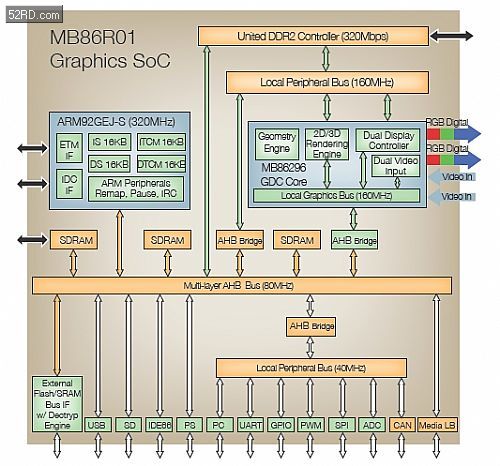
As a leader in this technology, Fujitsu has been active in the embedded graphics market for more than a decade and in the graphics field for nearly two decades, designing, developing and helping customers integrate leading-edge 2D and 3D graphics display controllers. So let’s review the basics of these powerful and innovative devices.
Many of the best graphics controllers available today can handle both 2D and 3D graphics. However, in many cases, system designers do not fully utilize the existing 3D capabilities that can bring many benefits to the end user. For example, in automotive applications, drivers want to know what a flat tire or a light is like when it is not working. Using 2D technology requires many preset images to highlight all possible angles and situations. Add in the “door or trunk ajar” scenario, and hundreds of megabytes of preset 2D images are required (Figure 2).
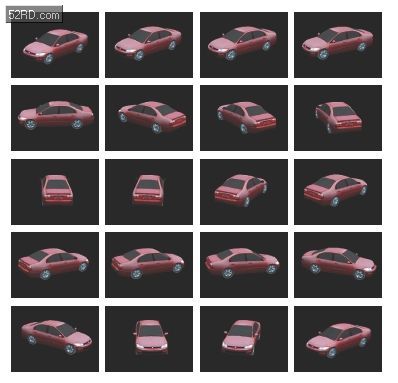

With 3D technology, all of these requirements and more can be easily accomplished with less than a megabyte of image and geometry data.
How 3D objects work
3D objects are made up of a "grid" of triangles that outline the object's specific shape. The more detailed the object, the more triangles are needed (Figure 4). The number of triangles that make up the shape of the object varies depending on how realistically you want the object to appear.
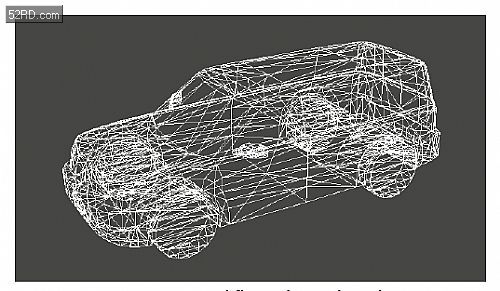
Each polygon has three vertices, and each vertex has an "x", "y", and "z" coordinate in "model space". These vertices are usually represented as a series of floating point numbers. The entire model is made up entirely of these floating point numbers, which make up the model's vertex array.
The next step is to "shade" or "texture" the model to make it look more like the real thing. The process of shading is simply filling each triangle with color. The triangles can be shaded in a single shade of gray or color, or in a Gouraud shaded way, where a gradient of colors is filled based on the color of each vertex (Figure 5).

To make objects look more realistic, other complex effects are added. Graphics display controllers with shading engines can implement other effects including water, smoke, fire, and reflective surface properties.
The process of applying a texture map is similar to adding prints to a plastic model to add realism. Like prints, texture maps transform a mesh-like framework into a more realistic image. A texture map is a 2D square image made up of multiple small individual images that are placed at specific locations on the polygonal mesh. These locations are specified in a table called a UV map, which contains the coordinates of each "print" in the texture map (Figure 6).
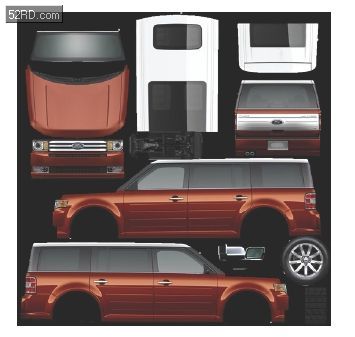
Once texture mapping is applied to a polygonal mesh, a complete 3D model can be created that has depth, can be rotated, scaled, and translated along three axes (x, y, z). After texture mapping is applied and the image processor processes the vertex and texture mapping data, you can see a complete 3D model as shown in Figure 7.
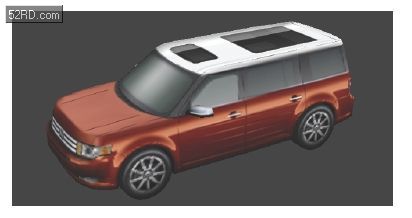
By using the graphics chip's geometry engine, this model can now be animated in any way and positioned from any angle. With just the 3D model (polygon mesh and texture map), and without any other data, you can present the 3D model in all its glory. By scaling, rotating and translating along the three axes of the 3D model, you have access to an unlimited amount of image data. As noted earlier, you can present any amount of information and cues, such as tire data, faulty lights and door conditions, without the need for expensive flash or system memory.
Fujitsu's "Jade" and "Emerald" are examples of proven graphics display controllers with complex 3D capabilities and leading graphics display properties. The MB86R0x Jade series graphics display controllers are used in a variety of automotive and industrial applications. The MB86R1x Emerald series graphics display controllers enable developers to realize more ambitious and complex 3D applications in the future.
Give full play to advantages
However, in many cases, existing applications do not take full advantage of Jade's 3D capabilities. This is a shame, because 3D technology can enable more complex graphics functions on existing platforms with only software changes. In other words, automakers, game developers and other consumer electronics companies can inject new blood into existing designs without the additional hardware engineering costs, because the hardware and displays that can support this function already exist.
So what does it take to use this feature? In the case of Jade, it's just a matter of using existing 3D software libraries. To make the process easier, the Jade helper library (Quantum) does most of the hard work of setting up geometry and drawing textures in the Fujitsu-provided graphics library (V03) (Figures 8 and 9). Emerald uses a graphics library similar to OpenGL ES 2.0.
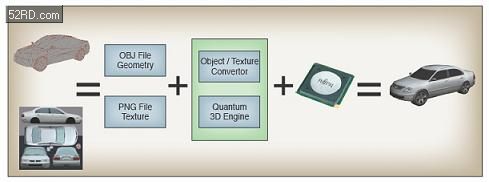

Jade and Emerald provide great support for 3D operation at their core. At least half of the graphics functions of these graphics display controllers are related to 3D technology, including:
3D basic elements - point, line, line strip, triangle, triangle strip, triangle fan, arbitrary polygon
Anti-aliasing
Gouraud shading, monochrome shading
Texture painting - filtering, perspective correction, blending modes, alpha color blending and masking techniques
Geometry processing - MVP transformation, clipping, filtering, viewport conversion
Z-buffer - eliminate hidden surfaces
Polygon drawing mark buffer
OpenGL ES 2.0 - compatible shader engine (Emerald only)
Previous article:USB3.0 is launched, how far can USB2.0 go?
Next article:DAC and its buffer help improve system performance and simplify design
- High signal-to-noise ratio MEMS microphone drives artificial intelligence interaction
- Advantages of using a differential-to-single-ended RF amplifier in a transmit signal chain design
- ON Semiconductor CEO Appears at Munich Electronica Show and Launches Treo Platform
- ON Semiconductor Launches Industry-Leading Analog and Mixed-Signal Platform
- Analog Devices ADAQ7767-1 μModule DAQ Solution for Rapid Development of Precision Data Acquisition Systems Now Available at Mouser
- Domestic high-precision, high-speed ADC chips are on the rise
- Microcontrollers that combine Hi-Fi, intelligence and USB multi-channel features – ushering in a new era of digital audio
- Using capacitive PGA, Naxin Micro launches high-precision multi-channel 24/16-bit Δ-Σ ADC
- Fully Differential Amplifier Provides High Voltage, Low Noise Signals for Precision Data Acquisition Signal Chain
- Innolux's intelligent steer-by-wire solution makes cars smarter and safer
- 8051 MCU - Parity Check
- How to efficiently balance the sensitivity of tactile sensing interfaces
- What should I do if the servo motor shakes? What causes the servo motor to shake quickly?
- 【Brushless Motor】Analysis of three-phase BLDC motor and sharing of two popular development boards
- Midea Industrial Technology's subsidiaries Clou Electronics and Hekang New Energy jointly appeared at the Munich Battery Energy Storage Exhibition and Solar Energy Exhibition
- Guoxin Sichen | Application of ferroelectric memory PB85RS2MC in power battery management, with a capacity of 2M
- Analysis of common faults of frequency converter
- In a head-on competition with Qualcomm, what kind of cockpit products has Intel come up with?
- Dalian Rongke's all-vanadium liquid flow battery energy storage equipment industrialization project has entered the sprint stage before production
- Allegro MicroSystems Introduces Advanced Magnetic and Inductive Position Sensing Solutions at Electronica 2024
- Car key in the left hand, liveness detection radar in the right hand, UWB is imperative for cars!
- After a decade of rapid development, domestic CIS has entered the market
- Aegis Dagger Battery + Thor EM-i Super Hybrid, Geely New Energy has thrown out two "king bombs"
- A brief discussion on functional safety - fault, error, and failure
- In the smart car 2.0 cycle, these core industry chains are facing major opportunities!
- The United States and Japan are developing new batteries. CATL faces challenges? How should China's new energy battery industry respond?
- Murata launches high-precision 6-axis inertial sensor for automobiles
- Ford patents pre-charge alarm to help save costs and respond to emergencies
- New real-time microcontroller system from Texas Instruments enables smarter processing in automotive and industrial applications
- AD09 cannot open AD files.
- AC servo motor based on STSPIN32F0
- Digital Circuit Design and VerilogHDL.pdf
- [GD32L233C-START Review] Review 2: Library function analysis, GPIO lighting
- Design of an ultra-low power micro-ECG stethoscope
- Modeling and simulation of power electronics and motor control systems
- NMOS+PMOS controls battery voltage output
- EEWORLD University - Designing wide input DC/DC converters for smart lock applications
- VS1053 module
- What is the temperature rise of a wire? How do you know the temperature rise of a wire?

 Digilent Vivado library
Digilent Vivado library Introduction to Deep Learning 2: Homemade Framework (Yasuki Saito)
Introduction to Deep Learning 2: Homemade Framework (Yasuki Saito)
















 京公网安备 11010802033920号
京公网安备 11010802033920号